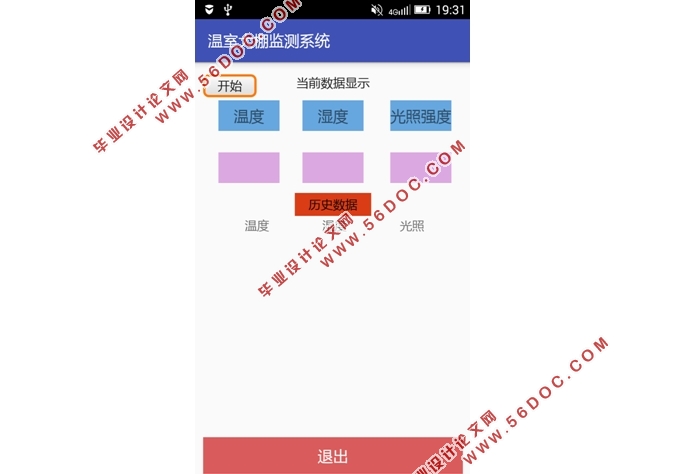基于安卓Android平台的农业大棚温湿度监控系统设计(Androidstudio)(论文10000字,程序代码)
摘要
从我国进入近现代以来,科学技术发展迅猛,各种农业新技术百花齐放。农业大棚,作为农业发展史上必不或缺的农业基础设施,成功实现了“反季节”种植的梦想。近几年来,智能农大棚也慢慢出现在我们的视野里。这一先进的农业管理方式,在被推广后,对于其技术支持的需求越来越多,市场需求量也开始增加。另一边,在谷歌公司开放了一套开源的操作系统——Android系统后,Android迅速占领手机市场,击败苹果公司的IOS操作系统,统治了移动设备开发端,成为手机应用开发领域领导者。这使得一大部分的Android移动设备迅速进入人们生活的各个方面,包括我们的基础行业——农业,并且推动其发展。
因此,本文设计了一份可以远程监测温室大棚数据的移动应用。其目的有二,一是寄希望能够降低我国农业生产的基础成本,希望可以通过此次设计出的理论与系统,让广大的农民朋友可以更好、更有效的劳作。第二,通过此次设计,能够加速我国智能农业的发展速度。当今的时代,技术发展日新月异,速度之快,令人咂舌,对于智能化农业大棚的需求也在步步提高。只有越来越多的农业方面的需求,才可以让相关农业发展和技术部门重视起来,从而推动我国智能化温室大棚的发展。
本套设计主要为一款基于手机安卓平台的软件,访问服务器数据并加以显示在Android手机客户端,以完成对数据的监控,并且能够在手机端实现对大棚环境数据的检测,以达到远程监测的目的。
关键词: 农业 温室大棚 数据监测 Android应用开发
Design of Temperature and Humidity Monitoring System for Agricultural Greenhouse Based on android Platform
Abstract
Since China has entered modern times, the rapid development of science and technology, all kinds of new agricultural technology flourishing. Agricultural greenhouses, as the agricultural development in the history of the necessary agricultural infrastructure, the successful realization of the "anti-season" cultivation of the dream. In recent years, intelligent agriculture greenhouses are also slowly appear in our field of vision. This advanced agricultural management approach, after being promoted, the demand for its technical support more and more, market demand began to increase. On the other side, Google opened a set of open source operating system - Android system, Android quickly occupied the mobile phone market, beat Apple's IOS operating system, dominated the mobile device development, a mobile application development leader. This makes a large part of Android mobile devices quickly into all aspects of people's lives, including our basic industry - agriculture, and to promote its development.
Based on the above content, this paper designed a greenhouse environmental parameters (temperature, humidity and other parameters) data monitoring system. Its purposes with some aspects, one is hoping to reduce the basic cost of agricultural production in China, hoping to design the theory and system, so that the majority of friends can be better and more effective labor. Second, through this design, we can promote the development of intelligent greenhouse greenhouses in China's basic agriculture. Today's era, technology development with each passing day, the speed is fast, staggering, for the demand for intelligent agricultural greenhouses are also step by step to improve. Only more and more agricultural requirement, can the relevant agricultural development and technical departments to pay attention to, so as to promote the development of China's intelligent greenhouse.
This set of design is mainly based on a mobile phone Andrews platform software, access to server data and be displayed on the Android phone client to complete the monitoring of data, and can be achieved on the mobile phone side of the greenhouse environment data detection, to achieve remote monitoring the goal of.
Key words: agricultural greenhouse data monitoring Android application

目录
摘要 Ⅰ
Abstract Ⅱ
第一章 绪论 3
1.1 课题背景 3
1.1.1农业发展 3
1.1.2国内外的发展与趋势 3
1.1.3 现代技术应用的助推作用 4
1.1.4我国相关技术发展可能遇到的问题 4
1.2 本文的工作内容 5
1.3 本章小结 5
第二章 课题涉及的技术与相关工具的简介 6
2.1 Android系统 6
2.1.1 系统架构 6
2.1.2 系统简介 6
2.1.3 Android发展简史 10
2.2 Android开发平台简介 13
2.2.1 集成环境IDE 13
2.2.2 Android Studio开发平台简介 13
2.3 Webservice简介 14
2.4 本章小结 14
第三章 基于 Android的移动端应用设计 15
3.1 登录与注册功能实现 15
3.1.1 登录功能 15
3.1.2 注册功能 17
3.1.3 密码重置 18
3.2 主界面设计 20
3.2.1 界面布局设计 20
3.2.2 数据监测显示功能 22
3.3 数据访问功能 23
3.4 历史数据查询功能 26
3.4.1 SQLite数据库及使用方法 26
3.4.2 历史数据功能实现 26
3.5 本章小结 28
第四章 应用调试 29
第五章 总结 30
参考文献 31
|



